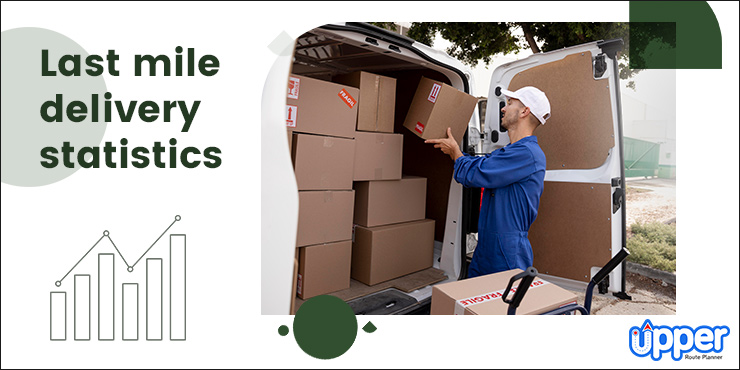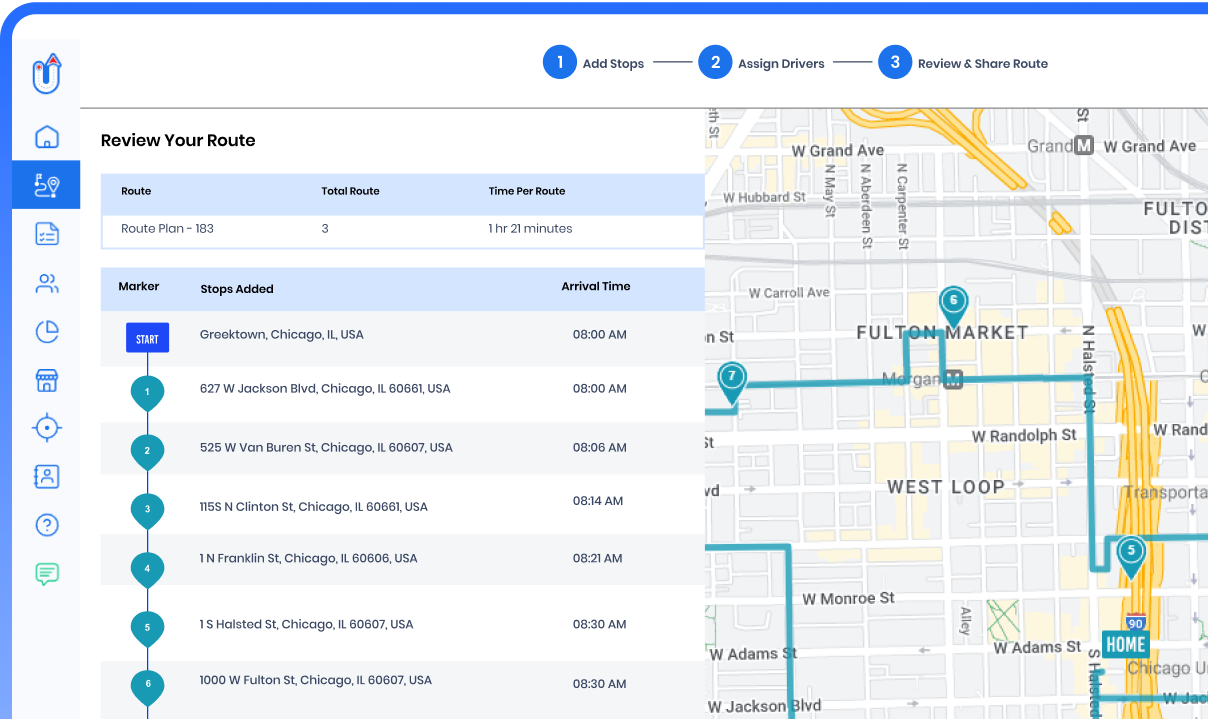

Do you know that the customer retention ratio is directly linked to the efficiency of last-mile delivery?
When deliveries are timely, accurate, and cost-effective, customer satisfaction soars, leading to repeat business and positive word-of-mouth.
However, achieving this level of efficiency is a challenging task.
Because of unwanted delivery delays, unhappy customers, and unnecessary wastage of fuel costs over missed or failed deliveries, it becomes difficult for logistics operators to streamline this final leg of the supply chain journey.
So, what’s the key to overcoming these challenges and excelling in last-mile delivery? Staying informed about the latest statistics and trends can be the one.
In this blog, we’ll delve into the emerging trends and current industry statistics shaping last-mile delivery operations in 2024.
By understanding and leveraging these insights, logistics professionals can enhance delivery processes, reduce costs, and improve customer satisfaction.
Forget Spaghetti Routes, Optimize Routes for Your Entire Team with Upper

Table of Contents
Go through the below-mentioned last-mile delivery statistics and trends to understand the current market scenario and future directions of this critical part of the supply chain:
The global last-mile delivery market was valued at $132.71 billion in 2022 and is expected to grow at a compound annual growth rate (CAGR) of 8.8% from 2023 to 2030.
The key factors influencing the growth of the last-mile delivery market include rising consumer expectations for same-day or next-day deliveries, the imperative for real-time tracking and visibility, the ascent of on-demand services, and the restrictions posed by urban congestion and sustainability considerations.
Revenue in the e-commerce market is projected to reach $4,117.00 billion in 2024. Revenue is expected to show an annual growth rate (CAGR 2024-2029) of 9.49%, resulting in a projected market volume of $6,478.00 billion by 2029.
McKinsey’s research says that the e-commerce industry experienced a growth rate of 10 years in just 3 months, especially after the COVID period.
Reports suggest the last-mile delivery software market was valued at $7 billion in 2021. With a CAGR of 9.3% from 2023 to 2030, it’s expected to reach $16 billion by 2030.
70% of consumers seek speedy, convenient, and friendly delivery service. Considering this, we do have data showing that 60% of users pay for faster deliveries while 69% of them pay for next-day delivery.
However, running same-day delivery at scale presents multiple challenges. They include real-time order visibility and tracking (51 percent) and travel time between the delivery points (49 percent).
However, modern route planning and optimization software like Upper provides real-time insights while your drivers are on the road.
With Upper’s advanced GPS tracking ability, you can track driver locations and adjust routes for unexpected situations or last-minute orders. and ensure timely deliveries.
Digital shoppers are increasing. In 2022, there were 268 million online shoppers in the United States, and this number is projected to increase to almost 285 million online shoppers in 2025.
However, less than half of these digital shopper say retailers meet their delivery expectations.
Back then, a survey was conducted by eMarketer, reported by TMCnet.com, which found that just 45% of online shoppers say that retailers meet delivery expectations, indicating there’s a big opportunity for route planning and optimization software brands that can get delivery right.
As per the World Economic Forum’s report, last-mile deliveries in urban areas are predicted to increase by 78% in the year 2030.
The autonomous last-mile delivery market should reach $4.96 billion by 2030. Because of the rapidly evolving retail and e-commerce market, the Asia-Pacific autonomous last-mile delivery market will grow at a CAGR of 17.5 percent from 2021 to 2028.
Let’s see some real-life examples:
Companies, such as Domino’s Pizza, are experimenting with self-driving vehicles and autonomous vehicles to streamline their delivery operations. This modern approach to delivering food will improve delivery times and lower operating costs. This ultimately reduces reliance on human labor and boosts the customer experience.
Another key player illustrating autonomous delivery robots is Starship Technologies. It operates a team of 1,700 robots and records about 10,000 deliveries daily.
As per Bringg’s survey conducted in January 2022, more than half of retailers rely on manual, inefficient order planning and dispatch. In this survey, 55% of retailers responded that the inefficiency of their current manual planning and dispatch process is a significant pain point.
To curb these challenges, giant businesses like DHL and Tesco are implementing AI-powered route optimization tools that are most effective at finding cost-efficient routes.
For example, DHL implemented a dynamic routing algorithm, Greenplan, that saved 20% on delivery costs and computational time compared to traditional route optimization tools.
Tesco’s AI-powered vehicle routing and scheduling system, on the other hand, contributed to a savings of 11.2 million miles and 8% fuel per order.
Check the role of AI in transforming last-mile delivery.
Survey reports by Capgemini state that 55% of retailers will switch to another retailer or brand that offers faster delivery service. 68% of online consumers consider shorter delivery windows the determining factor when placing an online order.
On the other hand, reports by Flash Box suggest that for 72% of online shoppers, convenient delivery time slots or customer-preferred time slots matter more than fast delivery.
Accelerate Delivery Success Rate
Take advantage of Upper's time window option to align your deliveries with customer availability, reducing the chances of failed deliveries.
Wrong addresses can directly lead to failed deliveries. According to data outsourced by Enterprise Times, 74% of businesses consider bad address data to be the cause of as many as one of four failed deliveries.
Efficient Address Verification
With Upper, you can detect wrong or duplicate addresses the moment you enter stops. This early detection helps you plan the optimal routes, avoiding errors and unnecessary wastage of time, fuel, and resources.
Wondering what’s shaping the future of last-mile delivery? Here are some key trends that are significant reasons behind the effortless delivery of packages from the warehouse to the customer’s doorstep.
Adopting drone delivery has numerous perks, including reduced emissions and minimal reliance on human labor. Drones consume up to 94% less energy per package than traditional vehicles, making them ideal for less-populated, remote areas. Autonomous last-mile delivery solutions, including drones and robotic carts, can navigate traffic congestion and free up trucks for other deliveries, showcasing their efficiency in modern logistics.
Walmart, a known industrial leader, launched its drone delivery service in 2021 and expanded it to 36 stores in seven states. Partnering with DroneUp, Flytrex, and Zipline, Walmart completed over 6,000 drone deliveries in 2022, delivering popular items like cookies and rotisserie chicken in 30 minutes or less.
However, they face crucial challenges like vehicle capacity constraints and special landing requirements.
Achieving a sustainable last-mile supply chain is a collaborative effort among businesses and suppliers adhering to environmental standards. A few things to consider while practicing sustainability in your last-mile delivery operations are:
Customers now expect real-time tracking of their packages. Enhanced transparency through GPS tracking, delivery status updates, and notifications helps improve customer satisfaction and trust. However, manual planning and optimizing delivery routes might fall short of these expectations.
By leveraging advanced technology and automated route planning solutions like Upper, businesses can provide more accurate and timely information to their customers, ensuring a seamless delivery experience.
The demand for same-day and instant deliveries is on the rise. Retailers and logistics providers are focusing on shortening delivery times to meet customer expectations for speed and convenience.
The use of micro-fulfillment centers located closer to urban areas is increasing. These centers help reduce delivery times and costs by storing inventory closer to the customer location. By strategically placing these centers, businesses can ensure faster deliveries and better inventory management, enhancing overall efficiency in the supply chain.
Utilizing gig economy workers for last-mile delivery is becoming more popular. This approach offers flexibility and scalability, especially during peak times, though it currently represents a small percentage of last-mile delivery methods. Crowdsourced delivery can help businesses manage fluctuating demand and expand their delivery capabilities without needing a large permanent workforce.
Leveraging big data and analytics to optimize delivery routes, predict demand, and improve operational efficiency is becoming standard practice. Data-driven insights help companies make informed decisions and enhance overall performance.
Last-mile delivery refers to the final step of the delivery process, where a package is transported from a distribution center to the end customer. It is crucial because it directly affects customer satisfaction, delivery speed, and logistics costs.
Some of the latest trends in last-mile delivery include the use of drones and autonomous vehicles, crowdsourced delivery models, same-day and next-day delivery services, advanced route optimization, and sustainable delivery practices.
Some real-world scenarios include Amazon’s use of delivery drones, UPS’s ORION route optimization system, and Walmart’s partnership with autonomous vehicle companies for grocery delivery. These innovations demonstrate how technology can improve efficiency and customer satisfaction in last-mile delivery.
Multiple challenges exist in last-mile delivery, including traffic congestion, managing customer expectations for fast delivery, ensuring package security, and reducing the environmental impact of deliveries. However, the major and the most significant challenge is rising shipping costs. As per the survey done by a worldwide study , the share of last-mile delivery out of total shipping costs has lifted from 41% to 53% between 2018 to 2023.
By investing in real-time tracking technology, route optimization, and fleet management software, offering flexible delivery options, and using environment-friendly delivery vehicles, you can improve last-mile delivery operations.
Key statistics related to last-mile delivery may include delivery time averages, customer satisfaction rates, cost per delivery, failure rates, and the percentage of deliveries made on time. These metrics help businesses measure and improve their delivery performance.
After considering all the trends and industry insights shared in the blog, it is much easier for any logistics or supply chain professional to kickstart their journey toward optimizing last-mile delivery operations. By staying informed about the latest advancements and implementing best practices, professionals can significantly enhance efficiency, reduce costs, and improve customer satisfaction.
For those looking to gain a competitive edge, Upper’s route planning and optimization software offers the perfect solution. With features designed to streamline delivery processes and provide real-time insights, Upper ensures that every package reaches its destination efficiently and on time. Try Upper Today!
Author Bio Rakesh PatelRakesh Patel, author of two defining books on reverse geotagging, is a trusted authority in routing and logistics. His innovative solutions at Upper Route Planner have simplified logistics for businesses across the board. A thought leader in the field, Rakesh's insights are shaping the future of modern-day logistics, making him your go-to expert for all things route optimization. Read more.
Share this post:Tired of Manual Routing?
Automate routing, cut down on planning time, dispatch drivers, collect proof of delivery, send customer notifications and elevate your team’s productivity. Unlock Simpler Routing